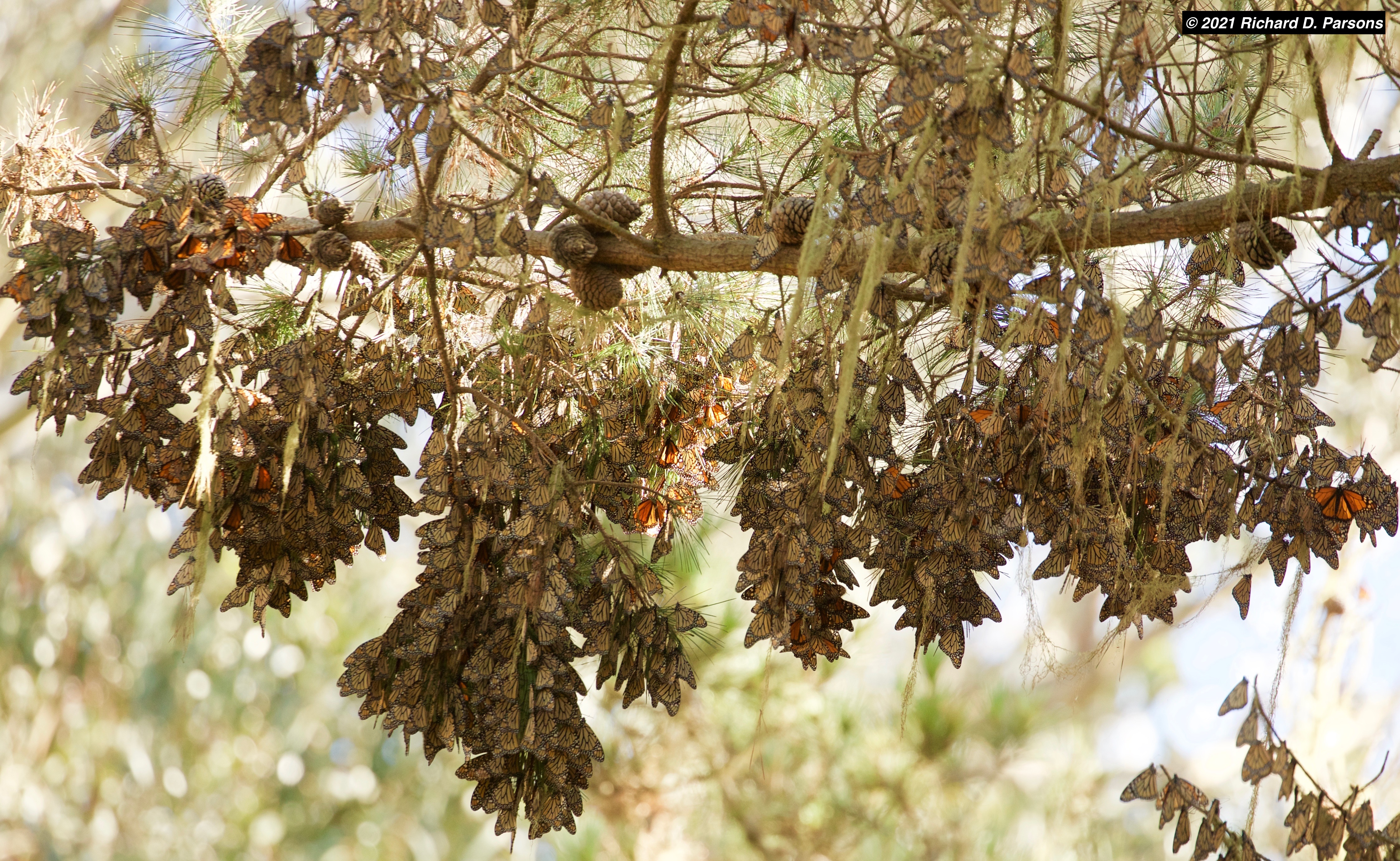Migratory western monarchs are being reported at their overwintering sites in coastal California in greater numbers than last year, giving hope for the struggling population. At overwintering sites in Pacific Grove, Pismo Beach, and a private site in Big Sur, over 10,000 monarchs have been counted at each site. Last year, these three sites had less than 300 monarchs in total. Additional clusters have been reported from Santa Cruz, Monterey, Big Sur, Ventura, Los Angeles and elsewhere. Altogether, as of November 12th, 2021, there appear to be at least 50,000 monarchs easily accounted for at the overwintering sites, with many sites yet unvisited.
These reports are particularly welcome after last year when the Western Monarch Thanksgiving Count reported an all-time low of less than 2,000 butterflies; this was preceded by two years of previously unprecedented lows of less than 30,000 butterflies.
These low numbers are a stark comparison to the millions of monarchs that overwintered in California in the 1980s, and the hundreds of thousands of monarchs that called these California forested groves home from the late 1990s to 2017. The past three years concern scientists as approximately 30,000 monarchs is thought to be the threshold below which the migration may further collapse (Schultz et al., 2017).
We now eagerly await the final count numbers as the Western Monarch Thanksgiving Count gets underway. The count is a volunteer-driven community science monitoring project coordinated by the Xerces Society and Mia Monroe, a count founder and longtime volunteer coordinator. The 25th annual count begins on Saturday, November 13 with the help of over 100 community scientists and professional biologists, and concludes on December 5.

Photo by Rick Parsons, Thanksgiving count volunteer, taken November 5th, 2021 at the Pacific Grove Butterfly Sanctuary in Pacific Grove, CA.
Does this mean western monarchs are recovering?
After last year’s count, what would happen in 2021 was a big question mark. We know that monarch butterfly populations, like other insects, are naturally "bouncy" in that they fluctuate from year to year in response to the temperature, rainfall, the availability of food, and other factors. The migratory western monarch population has undergone a sustained and significant decline and is now bouncing around in uncharted territory. We do not have much experience with migratory monarch populations when they reach this low level. Hence, seeing 50,000 in early reports is certainly a hopeful sign and evidence that the migration is definitely not gone, as some feared after last year.
However, it's crucial to remember that the modest uptick we're seeing is not population recovery or even evidence of an upward trajectory. If we were to count 50,000 butterflies this year, that would be about 25% of the count five years ago. In other words, if this count came in a few years ago, we would be quite concerned with how low these early numbers are. We must not normalize a new baseline and forget that we had hundreds of thousands of monarchs overwintering in California in the 2000s and 2010s, and over a million of monarchs in the 20th century.
This same lesson has been learned already with the migratory population in the East. In early 2019, the eastern monarch migratory population was estimated to cover 6.05 hectares of forest in Mexico, reaching the minimum population “goal” of 6 hectares and garnering a lot of hope that the population was increasing; however, the next two years, the population has dropped back below 3 hectares—evidence that the migration is still in jeopardy.
A useful analogy, outside of the butterfly world, may be the rain that many Californians are experiencing this fall after a prolonged dry spell. It’s more rain than expected, but it doesn't refill all the reservoirs nor mean that the drought is over. Many reservoirs are still critically low, water conservation measures are needed, and long term planning and adaptation to a drier future is more important than ever. Though we are likely to see increases in the size of the migratory western monarch population this year, and that is reason for hope, the population is still dangerously close to collapse and there remains an urgent need to address the threats that this butterfly faces.
Why are there more monarchs this year?
For many animal species, including insects, smaller populations can be more vulnerable to random fluctuations in the environment such as a bad winter storm, which is why recent Thanksgiving counts have been so concerning. On the flip side, smaller populations can also experience reduced competition for resources, like food, which can help them bounce back to higher numbers under favorable conditions.
Monarchs in the West have three to four (and sometimes more) generations a year, so their capacity to increase is large. If milkweed isn’t limiting, a female monarch can produce 12 adult daughters (Flockhart et al., 2015) and, under realistic conditions, approximately three or four daughters (Crone and Schultz 2021).
It is entirely plausible that migratory monarchs had good weather and good luck across their breeding habitat in the West this year and bounced up to a larger size than expected. While climate change-driven severe drought is associated with declines in butterfly abundance and diversity in the West overall, the effects are complex; warmer and drier summers—like 2021—can be a temporary boon to some butterfly species (Forister et al., 2021; Forister et al., 2018). Cooler fall temperatures are also thought to induce reproductive diapause and migration in monarchs, with the fall of 2021 being more typical conditions compared to last year’s warmer temperatures.
With only one year of a population increase, it is impossible to say whether this is the population clawing its way back from the brink or a blip in the continuation of the migration’s decline. We won’t know this until we have more years with either more or fewer monarchs.
Of course, there could be many other causes of this year’s monarch butterfly population growth besides good weather and good luck. Quite likely, it is due to a combination of factors. A number of research groups (including authors of this blog) are studying the important unknowns for western monarch butterflies, including the role of pesticides in the Central Valley, the status of winter breeding monarch butterflies in the San Francisco Bay area, and the connections between migratory eastern, migratory western, and resident western monarch butterfly populations in North America.
Other factors sometimes discussed in western monarch circles and that may have played a role in this year’s uptick, but currently lack sufficient evidence, include: changes in the timing and location of wildfires in the West, winter breeding monarchs in the Bay area, an influx from the eastern population, changes in crop planting and pesticide use in the Central Valley due to drought, etc. However, it’s important to note that these are hypotheses only and, as of yet, lack strong evidence to support them. We detail a few considerations of two of the more talked-about hypotheses, below.
Winter breeding monarchs
For decades, monarch butterflies have bred year-round on tropical milkweed in southern California cities (Urquhart et al., 1970). In recent years, monarch butterflies have started breeding year round on, primarily, non-native tropical milkweed (Asclepias curassavica) in urban gardens in the San Francisco Bay area. Last year, there was an apparent increase in this phenomenon, thanks to reports by community scientists (Xerces’ Western Monarch Milkweed Mapper; Crone and Schultz 2021). Whether this increase in winter breeding in urban areas has a net positive, neutral, or negative impact on the migratory population, we simply do not yet know (see a broader discussion in Crone and Schutlz 2021).
A recent paper (James and Kappen 2021) that has garnered media attention, supposes that this fall’s increase in overwintering numbers is due, at least partially, due to this “extra” winter breeding in the Bay area. In the paper, James and Kappen (2021) documented winter breeding at two locations on a handful of milkweed plants and found three quarters of the butterflies reared had significant rates of the protozoan parasite OE. This is similar to what other studies of winter breeding monarchs in California have found (Satterfield et al., 2016) and is quite concerning as high rates of OE can greatly reduce the lifespan, migration capabilities, and reproductive potential of monarchs. We do not want to introduce high rates of a debilitating disease to an already struggling migratory population! It's also worth noting that the paper tagged monarchs and reported an average resight distance of less than 1 mile and a maximum recovery distance of ~4 miles, with an average resight time of 3 weeks. Going 1 mile in 3 weeks is not compelling evidence of directional flight and certainly not of spring migration out of the area. Thus, it’s risky to conclude that all-is-well with winter breeding, given the disease impacts and many uncertainties.
In short, there is a possibility that winter breeding monarchs are contributing to the migration, and this may be more true in certain years when conditions are favorable. However, the evidence is lacking that winter breeding is the cause of this year’s uptick and it’s just as plausible that winter breeding monarchs are doing more harm than good to the population. This may be especially true in the long run as more sedentary behavior leads to high rates of disease and interrupts migratory behavior in monarchs, as seen in Florida, etc. In fact, the long-term presence of resident, winter breeding monarch butterflies in southern California makes one wonder why the dynamics would be different if monarchs undergo a similar sedentary shift in northern California.
Influx from eastern monarchs
Another idea that’s been around for a long time is the notion that western monarch butterflies could be rescued by immigration from the eastern monarch butterfly population. When conditions are right, we might see monarch butterflies that overwintered in Mexico colonize the western states in spring. This kind of recovery was hypothesized by Lincoln Brower and Robert Michael Pyle when monarch butterflies similarly rebounded from low numbers in the 1990s (Brower & Pyle 2004). This has further been supported by tagging programs in the Southwest documenting a portion of tagged monarchs being recovered alongside eastern monarchs in central Mexico overwintering sites (e.g., Morris et al., 2015). However, to date, no tags have been recovered to indicate a reverse spring migration from the Mexico overwintering sites back into the western U.S. As the western migratory population has gotten significantly smaller in recent years, the impact of even a small rate of migration from eastern monarchs would be greater. For example and strictly hypothetically, if we get an average of 5,000 eastern monarchs immigrating to the West per year, that would have no noticeable effect when there were hundreds of thousands of individuals, but a huge effect when there are <2,000. This could explain this year’s uptick without needing some kind of shift of behavior on the part of eastern monarchs.
How can I help monarchs?
Although we may not be able to say definitively why migratory western monarch butterflies are doing a little better this year, the better numbers are a reason to celebrate. It is also reason to double down on taking action to help them! There are lots of things we know people can do that help monarchs and other butterflies in the West. There are many habitat restoration projects in progress right now to enhance and restore monarch breeding and overwintering habitat in California, but more are needed and YOU can help.
- Plant native milkweed and flowers that provide nectar. Monarchs need milkweeds to lay eggs and provide food for their caterpillars and monarchs need nectar to fuel adult butterflies. Learn what plants help monarchs here.
- Reduce or avoid pesticide use. Find non-chemical alternatives to pesticides in your garden, support farmers & ranchers who are creating wildlife friendly habitat & reducing pesticide use, and seek out local plant nurseries that use fewer pesticides. Learn more here.
- Participate in community science. Tell us when you see monarchs and milkweeds in the West! Report your sightings on the Western Monarch Milkweed Mapper website and on iNaturalist (don’t forget to tag our project!). Each spring, there is an extra effort to report monarchs leaving overwintering sites, called the Western Monarch Mystery Challenge organized by authors of this blog. Other community science projects (not limited to the West) include Monarch Joint Venture’s Monarch Larva Monitoring Project and University of Wisconsin-Madison Arborteum’s Journey North. You can view many different community science projects here.
- Contact your elected officials and ask them to support the MONARCH Act. The MONARCH Act could provide critical funding for habitat restoration and research for the western population of monarchs, if passed. In order for it to pass, it needs stronger support from legislators. Please contact your elected representatives in Congress to ask them to sign on to the Monarch Act. Thanks to past support of the Monarch and Pollinator Highway Act, this bill was included in the recently passed infrastructure bill that is awaiting President Biden’s signature.
Funding for this year’s Thanksgiving and New Year’s counts is provided by the U.S. Fish and Wildlife Service, the San Diego Zoo Wildlife Alliance and Xerces Society members.
Acknowledgements: This blog sprang from many conversations with others thinking deeply about western monarch population dynamics. Particular thanks to Louie Yang, professor at the University of California-Davis, Collin Edwards, post-doc at Tufts University & Washington State University, and Sarina Jepsen & Isis Howard of the Xerces Society.




